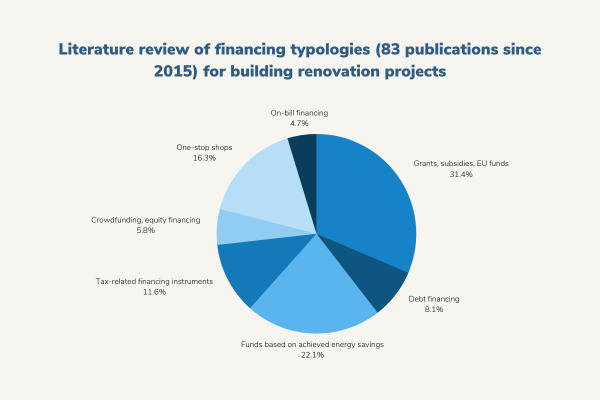Mitigating the consequences of the climate crisis is one of the most important pillars of current energy policies, and incentivising building renovation to reduce energy consumption is a promising but, unfortunately, often-overlooked strategy. To encourage the implementation of energy efficiency projects in the building sector, the financing of sustainable technologies for buildings needs to be facilitated. The ENERGATE project aims to contribute to this direction by creating a user-friendly marketplace, where building owners, asset managers, project developers and other market actors can be matched with financiers.
Hence, within the project, we have reviewed financing typologies for building renovation projects, examining 65 relevant literature and specific case studies, with the aim of identifying the most common financing instruments. Real case studies from Austria, Bulgaria, Czech Republic, Denmark, Estonia, Finland, France, Germany, Greece, Ireland, Italy, Latvia, Montenegro, the Netherlands, Portugal, Spain, Sweden and the United Kingdom have been reviewed.
The results of the research conducted reveal that a common financing instrument for retrofitting projects is grants, provided by governmental bodies or other institutions. Grants may be preferred because they are perceived as a risk-free funding option, since they are non-refundable, but over-reliance on such financing schemes should be avoided. Instead, other types of financing could be encouraged. Debt financing including green loans and energy efficiency mortgages is also commonly used and, quite often, combined with public financing resources such as grants, subsidies and tax incentives. Besides, when private investment is considered, debt and equity financing can be combined as well.

According to our findings, financing schemes for building renovation projects whose return on investment depends on achieved energy savings, are also gaining momentum. We are referring, of course, to the Energy Performance Contracts (EPCs): an Energy Service Company (ESCO) covers -entirely or partially- the initial costs of energy efficiency investments, retrofitting measures, installation of new systems and so on. So, how can the ESCO be paid back for the services they have provided? Naturally, thanks to the monetary savings resulted from energy savings.
Through our research, several alternative and less implemented financing options have also been identified, such as Energy Efficiency Obligations, which require involved (“obligated”) parties to achieve a certain threshold of energy savings, or on bill-financing schemes, that allow building owners to fund energy efficiency upgrades through utility bills. Financial rewards for energy efficiency achieved thanks to renovation can also be granted through Energy Efficiency Feed-in Tariffs (a similar mechanism to Feed-in Tariffs for renewable energy) and, finally, retrofitting actions can be financed even through crowdfunding platforms, that become more and more popular in a variety of domains. These interesting and innovative financing mechanisms could be furtherly explored and their potential to upscale building renovation in Europe or even globally should be increasingly assessed.
In a nutshell, what is the current status of renovation financing in the EU, what changes could be made in the future, and what could be role of the ENERGATE project and platform? A general objective for renovation projects in Europe would be the increase and encouragement of private investment, as opposed to the reliance on public non-repayable funds. Thus, such funds could be used as additional, supplementary resources, instead of being the most commonly applied financing options creating a number of problems (such as attracting free loaders or delaying projects due to lengthy and complicated procedures). The ENERGATE platform will aim to simplify processes and allow more effective contact between market actors, motivating asset managers and building owners to find the most suitable financing source for their projects, integrating ESCOs and project developers and taking into consideration the most important indicators as they will be clarified by pilot organisations representing different potential platform user profiles. Constant research and evaluation will continue to be conducted, so that the ENRGATE platform can effectively address the needs of the market and fill in the most prominent market gaps.
Read the whole report on Building Renovation Financing Typologies here.
Did you find this interesting?
The ENERGATE project is releasing more resources about the ENERGATE platform soon: a report on specifications for project entries, user profiles, use cases, and user ranks of the ENERGATE platform.
Stay tuned here!


